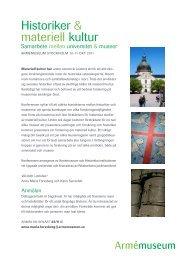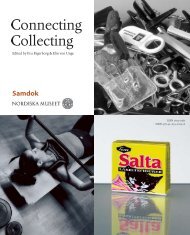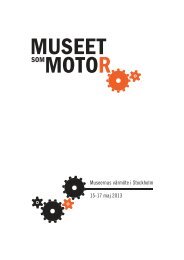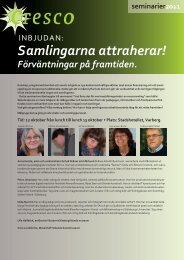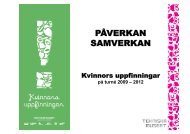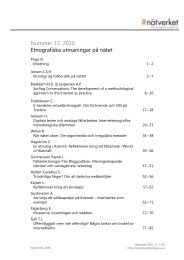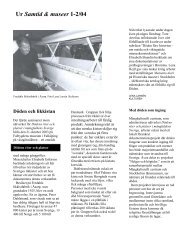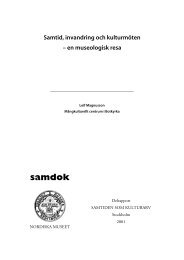Connecting Collecting - Sveriges Museer
Connecting Collecting - Sveriges Museer
Connecting Collecting - Sveriges Museer
You also want an ePaper? Increase the reach of your titles
YUMPU automatically turns print PDFs into web optimized ePapers that Google loves.
The Cultural Encounters GroupFrom projects carried out by the MulticulturalCentre, Botkyrka.Photo Andrzej Markiewicz ©MulticulturalCentre.cultural encountersof integration and cultural heritage. Inconcrete terms, this means that researchersare invited to the group, where eachmeeting includes reading and discussionof texts. The group has also startedan international exchange of experiencewith museums and organizations workingwith cultural encounter issues, andin autumn 2006 we had a study trip toGlasgow to meet colleagues.Theme and networkIn recent years the Cultural EncountersGroup has worked with the theme of“Rites and Places of Death in MulticulturalSweden”. A special network was establishedaround the theme, coordinatedby the Multicultural Centre. The workwas carried on for several years, withseminars in different parts of Sweden. Inaddition, Samdok held a method coursegeared to the theme. The network consistedof the Cultural Encounters Groupand interested parties from museums,universities, and others concerned withthe issue. Apart from the seminars therewere some small-scale studies undertakenat different museums and a majorexhibition by the Multicultural Centre,And Then? – An Exhibition about Death.The network and its work have also beenpresented in a theme issue of Samtid &museer.The Cultural Encounters Group alsocarries on a continuous dialogue withother Samdok pools about cultural encounters.Each member of the CulturalEncounters Group acts as contact personfor a pool. Originally this mostlyinvolved highlighting cultural encounterissues and getting these into the actionprogrammes of the pools. This task hasbeen accomplished, but the step of findingfields of study, formulating importantquestions and seeking relevance inthe work of the pools is a constant itemon the agenda.When the Cultural EncountersGroup was formed, an active stancewas taken to ensure that issues concerningimmigration (there was no talk ofintegration in 1993) should affect everysphere of society, every place and individual.This was an important aim whichwas ahead of the way people thoughtat the time. In 1997 the governmentintroduced similar goals in the integrationpolicy that we know today. In otherwords, Samdok and the museums werethinking ahead of their time then – butwhat is the situation today?Updating on all frontsThe call to “Update Sweden” means thatSwedishness can appear in many differentways. The challenge for those ofus who work with the present day is toinclude and establish a contemporarySwedish self-understanding in a cultural-historyparadigm. It is a matter ofbuilding on the Swedish cultural heritage– both material and non-material. It isa matter of returning to collections withnew questions and perspectives. It is amatter of connecting the present withthe past so that new Swedes have an opportunityto understand the oddities andtraditions that have constituted Swedishness.It is a matter of writing newpages in the unfinished biography of thenational project that is Sweden. It is amatter of not dismissing the boundarycrossingand hybrid social and culturaleveryday life in which people live. Thiswork requires a cultural encounter perspectivewhich can capture pictures oftoday’s complexity. Finally, we mustcontinue to document the present inmuseums. This is the method that linksdifferent eras with the collections. It isgratifying that we have more museumstoday that are interested in these issues,and this is a sign that augurs well for theissues themselves and for Samdok. pLeif Magnusson is director of the MulticulturalCentre and former chair of the CulturalEncounters Groupleif.magnusson@mkc.botkyrka.seReferenceMagnusson, Leif. “Invandring, kulturmöten,etnicititet.” In: Silvén, Eva & Gudmundsson,Magnus, eds. Samtiden som kulturarv: Svenskamuseers samtidsdokumentation 1975–2000.Stockholm: Nordiska Museet 2006. / Thepresent day as cultural heritage: Contemporarydocumentation by Swedish museums1975–2000.Samtid & museer no 2/07 • 7



